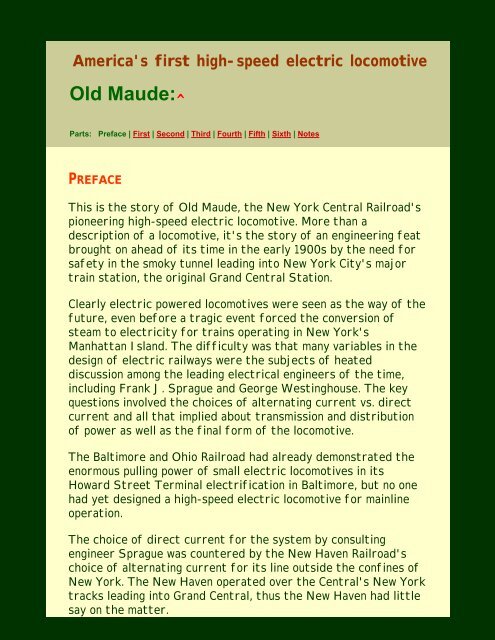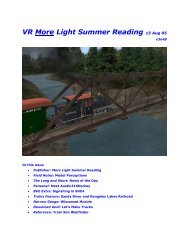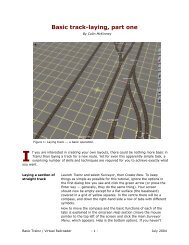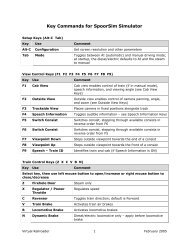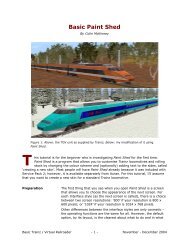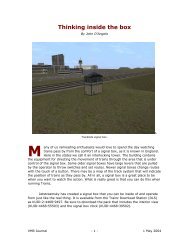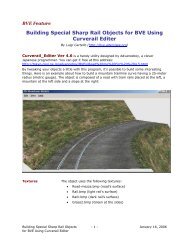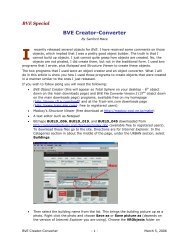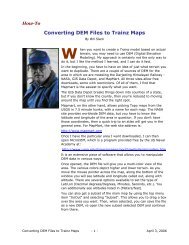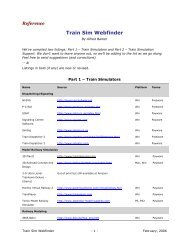Old Maude, Preface - Virtual Railroader
Old Maude, Preface - Virtual Railroader
Old Maude, Preface - Virtual Railroader
Create successful ePaper yourself
Turn your PDF publications into a flip-book with our unique Google optimized e-Paper software.
America's first high-speed electric locomotive<br />
<strong>Old</strong> <strong>Maude</strong>:^<br />
Parts: <strong>Preface</strong> | First | Second | Third | Fourth | Fifth | Sixth | Notes<br />
PREFACE<br />
This is the story of <strong>Old</strong> <strong>Maude</strong>, the New York Central Railroad's<br />
pioneering high-speed electric locomotive. More than a<br />
description of a locomotive, it's the story of an engineering feat<br />
brought on ahead of its time in the early 1900s by the need for<br />
safety in the smoky tunnel leading into New York City's major<br />
train station, the original Grand Central Station.<br />
Clearly electric powered locomotives were seen as the way of the<br />
future, even before a tragic event forced the conversion of<br />
steam to electricity for trains operating in New York's<br />
Manhattan Island. The difficulty was that many variables in the<br />
design of electric railways were the subjects of heated<br />
discussion among the leading electrical engineers of the time,<br />
including Frank J. Sprague and George Westinghouse. The key<br />
questions involved the choices of alternating current vs. direct<br />
current and all that implied about transmission and distribution<br />
of power as well as the final form of the locomotive.<br />
The Baltimore and Ohio Railroad had already demonstrated the<br />
enormous pulling power of small electric locomotives in its<br />
Howard Street Terminal electrification in Baltimore, but no one<br />
had yet designed a high-speed electric locomotive for mainline<br />
operation.<br />
The choice of direct current for the system by consulting<br />
engineer Sprague was countered by the New Haven Railroad's<br />
choice of alternating current for its line outside the confines of<br />
New York. The New Haven operated over the Central's New York<br />
tracks leading into Grand Central, thus the New Haven had little<br />
say on the matter.
More controversial was General Electric design engineer Asa F.<br />
Batchelder's selection of the previously tried and failed gearless<br />
drive for <strong>Old</strong> <strong>Maude</strong>, the project's prototype locomotive.<br />
The design of the entire Grand Central Terminal project,<br />
including the new terminal design conceived and guided by the<br />
Central's Vice-President and Chief Engineer William J. Wilgus,<br />
the system electrification, and the locomotive design has been<br />
validated by its long-running success. Grand Central remains<br />
today as an important rail center and the electrification remains<br />
virtually intact and unchanged since it reached completion in the<br />
early 1900s. <strong>Old</strong> <strong>Maude</strong> and her 46 siblings continued to provide<br />
trouble-free economical service for many years. The last to leave<br />
service was number 115, which was retired in 1981.<br />
This article is divided into eight parts:<br />
1. <strong>Preface</strong><br />
2. Observations of a young boy<br />
3. Grand Central electrification<br />
4. A bold new locomotive<br />
5. A fatal accident<br />
6. Years of grace<br />
7. Now you know<br />
8. Notes<br />
This article was originally written in 1992 for Electric<br />
Lines magazine. It was completed just as the magazine<br />
ceased publication. I've made a few trivial adjustments<br />
since then to account for the time gap since I first<br />
wrote the article. I've also added a few amplifying<br />
sidebars in recognition of the potentially wider<br />
audience the Internet affords as compared to the rail<br />
enthusiast focus of Electric Lines, but I have not<br />
updated any of the research.<br />
Alfred Barten, 1 June 2001.<br />
Parts: <strong>Preface</strong> | First | Second | Third | Fourth | Fifth | Sixth | Notes
©1998, 2001 Alfred Barten. All rights reserved.
America's first high-speed electric locomotive<br />
<strong>Old</strong> <strong>Maude</strong>:^<br />
Parts: <strong>Preface</strong> | First | Second | Third | Fourth | Fifth | Sixth | Notes<br />
OBSERVATIONS OF A YOUNG BOY<br />
I grew up watching trains. For one memorable period in my<br />
preteens, in the early 1950s, I had one of the best train<br />
watching seats in the country. It was Harmon, New York, where<br />
the New York Central changed its motive power on all through<br />
passenger trains to or from points north of Croton-on-Hudson.<br />
Electric locomotives headed trains into and out of New York's<br />
Grand Central Terminal to the south, while steam or diesel<br />
locomotives powered trains to the north.<br />
S-motor 144 at Harmon, NY, 24 June 1935. Photo by Francis J. Goldsmith, Jr.<br />
My father commuted to New York from Harmon, where my<br />
mother and I often met him in the evening upon his return. I had
little difficulty in persuading my habitually early mother to drive<br />
us to the station well in advance of his arrival so I could watch<br />
the changeovers. Perched on an embankment alongside the<br />
tracks, twenty or so feet above the station platforms, I saw a<br />
range of the Central's finest steam, diesel, and electric<br />
locomotives. For steam there were the omnipresent 4-6-2<br />
Pacifics; the speedy, handsome, classic 4-6-4 Hudsons; the<br />
powerful 4-8-2 Mohawks; the occasional Berkshires with their<br />
unforgettable 2-8-4 wheel arrangement; and the state-of-theart<br />
4-8-4 Niagaras. If my father was delayed and took a later<br />
train, I saw the big name trains - the Commodore Vanderbilt and<br />
the Twentieth Century Limited. These were often spirited to<br />
Chicago by A-B lashups of magnificent EMD E7 diesels dressed in<br />
the Central's handsome lightning color scheme, a stately<br />
combination of grays and white. The E7s' power, speed, and long<br />
line afforded them a legendary status in the minds of us boys.<br />
We held them in the same esteem as we did that other New York<br />
legend, the Yankee Clipper himself, Joe DiMaggio. Looking at the<br />
E7s, we saw the future, though with a touch of remorse for the<br />
doomed steamers.<br />
-----------------------<br />
Some steam locomotive designations by front-to-back wheel arrangements:<br />
Atlantic, 4-4-2: ooOOo<br />
Pacific, 4-6-2: ooOOOo<br />
Hudson, 4-6-4: ooOOOoo<br />
Mohawk, 4-8-2: ooOOOOo<br />
Berkshire, 2-8-4: oOOOOoo<br />
Niagara, 4-8-4: ooOOOOoo<br />
The following photos are on George Elwood's Erie Lackawanna and other Fallen Flag<br />
and Shortline Railroad Photos website:<br />
Pacific, 4-6-2: Harmon, NY, 8/19/1952 (J.R. Quinn photo, Gary Stuebben collection)<br />
Hudson, 4-6-4: Harmon, NY, 7/30/1950 (J.R. Quinn photo, Gary Stuebben collection)<br />
Mohawk, 4-8-2: Buffalo, NY, 1/4/53 (Gary Overfield collection)<br />
Niagara, 4-8-4: Harmon, NY, 05/30/1949 (Gary Stuebben collection)<br />
E-7 diesel: Harmon, NY, 5/18/1957 (David Nyce photo, Gary Stuebben collection)<br />
T-motor: Harmon, NY, 9/17/1954 (Paul L. Dunn photo, Gary Stuebben collection)<br />
P-motor: Harmon, NY, 07/11/1955 (Wm.Curtis photo, Gary Stuebben collection)<br />
-----------------------<br />
The electrics were usually T-class motors, the line's workhorses<br />
for nearly four decades until supplanted by the larger P-class<br />
motors, which were rebuilt and transferred in 1955 from<br />
Cleveland Union Terminal after that branch of the Central was<br />
de-electrified. Occasionally a solitary, diminutive S-class motor<br />
would arrive with an outbound train in tow and, with little
fanfare, return to New York heading an inbound train. Normally,<br />
S-motors could be seen lurking on sidings in and around Grand<br />
Central Terminal or in nearby Mott Haven yard. They were the<br />
nation's first-ever mainline, high-speed electric locomotives,<br />
created at a time when the foundling electric railroad industry<br />
was still seeking standards. The first group of S-motors was<br />
built in 1906 as part of the Central's pioneering Grand Central<br />
Terminal electrification. They gained instant fame when, in 1905,<br />
the series' prototype outperformed the Central's newest Pacifictype<br />
steam locomotive in trial runs at the General Electric test<br />
facilities in Schenectady. After their introduction into regular<br />
service in 1906, the S-motors became popular models for toy<br />
train manufacturers and thereby introduced a generation of<br />
children to the wonders of electric railroading.<br />
-----------------------<br />
Mott Haven Yard<br />
The tracks of the Central's Hudson and Harlem Divisions converge at Mott Haven<br />
Junction in the Bronx to begin the aproach to Grand Central Terminal at 42nd<br />
Street in Manhattan. Mott Haven Yard, a passenger coach facility, extends north<br />
from Mott Haven Junction, at 149th Street, along the Harlem Division. It is still in<br />
use today by the MTA Metro-North Railroad, the descendent of the New York<br />
Central and New Haven (and other) railroads, but is largely obscured by apartments<br />
built in the air space aove the yard.<br />
-----------------------<br />
The sequence of changing outbound locomotives at Harmon was a<br />
ritual I quickly learned. Before a given train arrived from Grand<br />
Central, the locomotive preparing for the train's real trip - the<br />
one from Harmon to Poughkeepsie, Albany, Buffalo, Canada,<br />
Cleveland, Toledo, Chicago, or elsewhere - would slowly back over<br />
the elevated track leading from the roundhouse or<br />
diesel/electric shops on the west (inbound) side to the east<br />
(outbound) side. This track, which was just north of the station,<br />
crossed over a maze of mainline and secondary tracks below. The<br />
elevated track led the locomotive down alongside and, finally,<br />
through a ladder of double-slip switches onto the mainline track<br />
where its train was to arrive. The locomotive, usually steam,<br />
would then pull ahead of the arrival point and wait. Upon arrival,<br />
the electric would be uncoupled, run ahead, and switched out of<br />
the way. The waiting locomotive would then back up and be<br />
coupled to the train. Moments later, amid great clouds of steam<br />
and smoke accompanied by resounding blasts of steam escaping<br />
the cylinders with each piston stroke, the massive steamer would<br />
gradually lurch forward with its heavy train. In one
unforgettable moment, I stood alongside a 4-8-4 Niagara when<br />
those 79-inch diameter drivers started. I was astonished to see<br />
the wheels skid as that giant piece of machinery, straining under<br />
its load, took several strokes to finally gain a foothold. In that<br />
moment I felt the magnitude of the forces at work.<br />
The diesels, though less spectacular, created an impressive<br />
commotion of their own when their 4000-horsepower's worth of<br />
internal combustion engines roared into action.<br />
What could have passed unseen amid this awesome display of<br />
power, but didn't, was the unassuming ease with which the<br />
electric locomotives delivered their trains to the waiting steam<br />
and diesels. Quietly, effortlessly, unceremoniously they arrived<br />
and were uncoupled and jockeyed to an inbound track for the<br />
return trip to Grand Central. A cartoon equivalent of this<br />
incongruous sequence is the bent, gray-haired cleaning woman<br />
singlehandedly picking up and moving the champion weightlifter's<br />
barbells to dust under them. How these undersized boxes on<br />
wheels could outperform their more celebrated steam or diesel<br />
counterparts was a mystery. As much a mystery was the<br />
electrics' curious shapes that revealed little of their underlying<br />
nature and concealed the transformation of electrical energy to<br />
mechanical motion.<br />
These were true "black boxes." S-motor number 6000, the<br />
Central's 1904 prototype also known as <strong>Old</strong> <strong>Maude</strong>, could have<br />
been the original "black box," though it wasn't. That title would<br />
be more fitting for the tiny four-wheel electric locomotives built<br />
in 1890 for the City & South London's deep-tube subway.<br />
External appearances left little clue as to how the S-motor<br />
worked. With its center cab and biaxial symmetry, there was<br />
even doubt as to which way it might move next. There were no<br />
side rods connecting its drive wheels to suggest that it could<br />
move of its own accord. When it did move, there was little sound<br />
from inner activity. There was no steam for propulsion nor smoke<br />
nor exhaust from combustion. There were no overhead wires<br />
from which to gain electrical energy. The stunted pantographs<br />
appeared more like antennae. Only a close observation would<br />
reveal the frame-mounted contact shoes which pressed the<br />
underside of the energized third rail. Appropriately, the<br />
locomotive was painted black; all black save for the gold letters<br />
and numbers.
The greater mysteries of the electric locomotive are in its<br />
performance - tractive effort, acceleration, speed - and the<br />
unseen properties of magnetism and electricity. The principles of<br />
steam were known at the start of the nineteenth century. "By<br />
the end of the century the basic elements of the steam<br />
locomotive and their functions were quite well understood, and<br />
very few unsound designs have been built since that time,"[1]<br />
wrote Alfred Bruce in his 1952 compendium The Steam<br />
Locomotive in America: Its Development in the Twentieth<br />
Century. It was not hard to understand or demonstrate the<br />
processes of combustion, vaporization, pressure, and conversion<br />
to mechanical motion. Even the internal combustion engine at the<br />
heart of the diesel-electrics is readily understandable.<br />
-----------------------<br />
1. Bruce, Alfred W. The Steam Locomotive in America: Its Development in the<br />
Twentieth Century. New York: Bonanza Books, 1952; 28.<br />
-----------------------<br />
But grasping the fundamentals of electricity, magnetic induction,<br />
and the like still takes a leap of faith for many. The results of<br />
the processes are observable. The processes themselves often<br />
are not. In his 1890 poem, "The Broomstick Train; or, The Return<br />
of the Witches," Oliver Wendell Holmes observed:<br />
Often you've looked on a rushing train,<br />
But just what moved it was not so plain.<br />
It couldn't be those wires above,<br />
For they could neither pull nor shove....[2]<br />
-----------------------<br />
2. Holmes, Oliver Wendell. Complete Poetical Works. Ed. Horace E. Scudder.<br />
Boston: Houghton, 1895; 301.<br />
-----------------------<br />
If the processes are difficult to "see" today, they were less<br />
understood at the start of twentieth the century. When the<br />
Central's electrification and accompanying S-motor prototype<br />
were designed, virtually every major component of the system<br />
and locomotive was a subject for debate. At issue were the type<br />
of distribution current and its voltage, the distribution system<br />
itself, the locomotive motor(s), and the form of drive. There<br />
were "safe" approaches, of course, but would they be best in the<br />
long run?
Alfred Barten, 16 January 1993.<br />
This is the first part of an article written in 1992 for<br />
Electric Lines magazine, just before it ceased<br />
publishing.<br />
Parts: <strong>Preface</strong> | First | Second | Third | Fourth | Fifth | Sixth | Notes<br />
©1998, 2001 Alfred Barten. All rights reserved.
America's first high-speed electric locomotive<br />
<strong>Old</strong> <strong>Maude</strong>:^<br />
Parts: <strong>Preface</strong> | First | Second | Third | Fourth | Fifth | Sixth | Notes<br />
GRAND CENTRAL ELECTRIFICATION<br />
In 1903, when the Central began planning its Grand Central<br />
Terminal electrification, the lure of electric operation was<br />
certainly in the air. Trolleys were already taking the country by<br />
storm and the first round of electric interurban building was well<br />
under way. Chicago had been operating multiple-unit rapid transit<br />
trains system-wide since 1900 and the Baltimore & Ohio Railroad<br />
had demonstrated the remarkable pulling power of electric<br />
locomotives with its Howard Street Tunnel electrification in<br />
1895. The Central had been considering electrification since<br />
1899 but was in no hurry, what with serious questions<br />
surrounding the best choice of system.[3] A fatal accident in<br />
1902, however, left no alternative. On January 8 a New York<br />
Central morning rush-hour train ran a red light in the smokefilled<br />
Park Avenue tunnel and rear-ended a stopped New Haven<br />
train, killing fifteen commuters. The public outcry was so great<br />
that the Central moved to action even before the State<br />
Legislature, on May 7, 1903, officially banned the use of steam<br />
locomotives on the Grand Central line south of the Harlem River<br />
after July 1, 1908.<br />
-----------------------<br />
3. Wilgus, William J. Electrification of the New York Central & Hudson River<br />
Railroad in the New York Zone. Street Railway Journal. October 8, 1904; 584.<br />
-----------------------<br />
The Central formed a commission to study the situation and<br />
make recommendations as to the general nature of the<br />
electrification. The Electric Traction Commission, as it was<br />
named, was well-staffed with engineering talent, including two<br />
who would play important roles: the Central's Vice-President and
Chief Engineer William J. Wilgus, and reknowned consultant,<br />
Frank J. Sprague. The former devised the brilliant two-level<br />
scheme for the new Grand Central Terminal while the latter most<br />
certainly had a guiding influence (though he downplayed it) in the<br />
selection of low-voltage third-rail direct current (d.c.) for the<br />
power distribution system. As reported by Wilgus, the group met<br />
weekly and set "principles and policies" to be "carried out by a<br />
technical corps under the jurisdiction of the electrical<br />
engineer."[4]<br />
-----------------------<br />
4. Wilgus, William J. Electrification of the New York Central & Hudson River<br />
Railroad in the New York Zone. Street Railway Journal. October 8, 1904; 584.<br />
-----------------------<br />
To be sure, there were compelling reasons for the Central's<br />
selection of 650-volt d.c. over the competing 11,00-volt singlephase<br />
alternating current (a.c.). For one thing, d.c. had already<br />
been proven in urban and suburban situations, whereas a.c.,<br />
despite its acknowledged advantages in efficient line<br />
distribution, had not been demonstrated in any major installation.<br />
There were more convincing arguments in support of d.c. for the<br />
Grand Central Terminal electrification, though: 1) the use of a.c.<br />
would require lowering tracks to provide clearance beneath<br />
overpasses for the overhead distribution wires, and 2) the<br />
clincher, a New York City ordinance prohibited the use of<br />
unprotected high tension wires (as in overhead distribution<br />
systems).
S-motor 133 at Mott Haven Yard, NY, April 1965. Bob's Photo.<br />
Another reason given in support of the low-voltage d.c.<br />
installation was the "desirability of harmonizing all of the larger<br />
electrical installations in the New York vicinity, such as elevated,<br />
surface railways and subways."[5] The intention was to provide<br />
"11,000-volt three-phase alternating current for high-pressure<br />
transmission between the central power stations and the<br />
substations, and 600-volt direct current for the low-pressure<br />
conductors and third rail."[6] There was even an intimation that<br />
a connection might be made with the rapid transit subway<br />
(already using low-voltage d.c.) at 42nd Street, the site of the<br />
planned new Grand Central Terminal.[7]<br />
-----------------------<br />
5. Wilgus, William J. Electrification of the New York Central & Hudson River<br />
Railroad in the New York Zone. Street Railway Journal. October 8, 1904; 584.<br />
6. Ibid; 585.<br />
7. Ibid; 584.<br />
-----------------------<br />
The Central's commitment to d.c. extended to its suburban<br />
electrification, which included radiating lines to Yonkers and<br />
North White Plains in addition to the mainline Hudson Division as<br />
far as Croton-on-Hudson. Whereas the New Haven Railroad,<br />
which shared Grand Central Terminal facilities and approaches<br />
with the Central, chose to use 11,000-volt single-phase catenary<br />
a.c. once outside the city and on its own right-of-way (and put
itself at the cutting edge of railroad electrification technology),<br />
the Central planned instead to eventually extend its Hudson<br />
Division electrification as far north as Albany with low-voltage<br />
d.c. (The superiority of a.c. as a distribution system ultimately<br />
discouraged any serious expansion of the Central's<br />
electrification. The New Haven, after experiencing early<br />
difficulties to the point of nearly abandoning its a.c. system,<br />
extended its electrification to New Haven and set the standard<br />
to be followed decades later by the Pennsylvania Railroad in its<br />
electrification of what is now Amtrak's Northeast Corridor. As<br />
of this writing, that system is expected to be extended all the<br />
way to Boston.)<br />
S-motor 110 at North White Plains, NY, 13 November 1966. Photo by Francis J.<br />
Goldsmith, Jr.<br />
A paper presented by Sprague at a meeting of the American<br />
Institute of Electrical Engineers on May 21, 1907, provides some<br />
insight into the Central's choice of system and the design of the<br />
S-motors, so integral a part of the overall plan. What is<br />
interesting is that by 1907 many of the claimed advantages of<br />
d.c. over a.c. were discounted by at least some engineers, as was<br />
evident by the comments of those attending the meeting. Yet<br />
Sprague's approach to electrification remained unchanged.<br />
Foremost in Sprague's approach was the assertion that the<br />
locomotive's motor (Sprague's forte) is the starting point, the<br />
key element, the first variable in the design process to be fixed.<br />
For Sprague, this pointed to the d.c. motor because of its
greater simplicity, efficiency, and reliability. Building on these<br />
three factors, the remaining components fall into place:<br />
Specifically, the use of third-rail distribution, with its proven<br />
reliability, to provide the carrying capacity required by the low<br />
voltage; and the design of a locomotive that would exploit the<br />
theme of simplicity, efficiency, and reliability to the fullest<br />
extent possible. (In support of Sprague's position, the d.c.<br />
traction motor has until recently been the de facto standard for<br />
today's electric and diesel-electric locomotives.)<br />
These above considerations are of paramount importance in any<br />
electrification because of the need to write off the project's<br />
large initial investment. This was especially true of low-voltage<br />
d.c. (with its expensive distribution system), which Sprague<br />
characterized as the unequivocal choice for high-density traffic.<br />
"The present hope of usefulness of the single-phase system," he<br />
said, "is on roads of considerable extent which operate an<br />
irregular and sparse traffic, and where only a moderately<br />
expensive, or what may be called second-class overhead<br />
construction which will keep down the ratio of line investment to<br />
that of the balance of the equipment, is tolerable."[8] If<br />
Sprague's remark, made in his May 1907 presentation, didn't<br />
ruffle a few a.c. feathers, a subsequent remark must certainly<br />
have:<br />
-----------------------<br />
8. Sprague, Frank J. Some Facts and Problems Bearing on Electric Trunk-Line<br />
Operation. Street Railway Journal. May 25, 1907; 907.<br />
-----------------------<br />
But whatever may be the future of single-phase<br />
operation under the conditions stated, any present<br />
claim for it as preferable equipment for congested<br />
service demanding high schedules and great capacity is<br />
not worth a moment's thought, for in this field, at<br />
least, it cannot touch the direct-current system.[9]<br />
-----------------------<br />
9. Sprague, Frank J. Some Facts and Problems Bearing on Electric Trunk-Line<br />
Operation. Street Railway Journal. May 25, 1907; 915.<br />
-----------------------<br />
The success, if not also the ultimate validity, of Sprague's<br />
approach has been borne out by the durability of the Central's<br />
electrification and the S-motors in particular. The installation is
still in operation and the last of the S-motors survived till the<br />
early eighties, after nearly eight decades of virtually troublefree<br />
day-in and day-out service.<br />
Alfred Barten, 16 January 1993.<br />
This is the second part of an article written in 1992 for<br />
Electric Lines magazine, just before it ceased<br />
publishing.<br />
Parts: <strong>Preface</strong> | First | Second | Third | Fourth | Fifth | Sixth | Notes<br />
©1998, 2001 Alfred Barten. All rights reserved.
America's first high-speed electric locomotive<br />
<strong>Old</strong> <strong>Maude</strong>:^<br />
Parts: <strong>Preface</strong> | First | Second | Third | Fourth | Fifth | Sixth | Notes<br />
A BOLD NEW LOCOMOTIVE<br />
For all the apparent conservatism in the selection of d.c. as the<br />
system of choice, the S-motor design was a bold departure from<br />
earlier electric locomotives. It was primarily the work of General<br />
Electric's Asa F. Batchelder, who patented four of the design's<br />
features. Most significant was a Batchelder innovation that<br />
produced the first successful use of bipolar gearless motors.<br />
Sectional elevation of <strong>Old</strong> <strong>Maude</strong>. Street Railway Journal, 1904.<br />
The lure of the gearless motor is the absence of gears, which by<br />
their very nature introduce friction (with its loss of operating<br />
efficiency) and require maintenance. In practice a gearless<br />
motor design is achieved by wrapping the motor armature around<br />
the driving wheel axle. This has the drawback of adding dead<br />
weight to the axle, which in turn lowers the locomotive's center<br />
of gravity, a detriment to good tracking. In an age of early motor<br />
design, placing the armature on the axle also limited the capacity<br />
of a motor by restricting its size to the space available between<br />
the wheels. Previous gearless designs usually placed the armature<br />
in a hollow quill that surrounded but did not contact the axle.
The motor's fields were placed in the motor casing, which<br />
surrounded the quill and was attached to the locomotive frame.<br />
The quill ends were fastened to the drive wheels via springs or<br />
rubber to allow a flexible connection that reduced the unsprung<br />
weight of the motor and mitigated some of the stresses of<br />
starting and accelerating on the wheels and motors.<br />
The B&O used a gearless quill drive in its historic locomotives of<br />
1895 but chose geared drives instead for its second generation<br />
of locomotives in 1903. The New Haven also used gearless quills<br />
in its initial a.c. locomotive fleet of 1907 and likewise turned to<br />
geared quill drives for subsequent designs.<br />
But Batchelder chose a gearless drive that omitted the quills<br />
altogether. Such an attempt had only been tried on an<br />
"important" installation once before.[10] That was on the<br />
locomotives for the 1890 deep-tube electrification of the City &<br />
South London Railway in England. The C&SL attempt was a<br />
disappointment, though, and the locomotives' pounding of the<br />
rails soon led to the use of multiple-unit motor cars in place of<br />
the locomotive-drawn trains. Thus Batchelder's initiative drew a<br />
good deal of attention throughout the industry.<br />
-----------------------<br />
10. High-Speed Electric Locomotive for the New York Central & Hudson River<br />
Railroad. Street Railway Journal, November 19, 1904; 901.<br />
-----------------------<br />
There were two significant differences between the C&SL<br />
attempt and the Central's. First, the London installation was said<br />
to be very light, and the vibrations from running were readily<br />
"transmitted to and propogated in the surrounding soil of London<br />
clay in a way which could not be possible on a roadbed of the<br />
character of the New York Central."[11] Second, in the C&SL<br />
design the entire motor was axle-mounted, which produced a<br />
relatively greater unsprung weight, a large contributor to railpounding.<br />
In the Batchelder design only the motor armature was<br />
mounted on the axle. The pole pieces were mounted on the truck<br />
frame. The resulting 11,000-lb dead weight of each axle, drive<br />
wheels and armature included, was "somewhat less than is<br />
customary with steam locomotives."[12] Since the most<br />
problematic element of the steam locomotive as regards wear on<br />
the track is the "impossibility of properly balancing the<br />
reciprocating motion of connecting and driving rods"[13]
(completely absent in gearless designs), the concern for pounding<br />
the rails was heavily discounted. Engineers expected a twenty to<br />
thirty percent reduction in wear from that of a comparable<br />
steam locomotive.[14]<br />
-----------------------<br />
11. High-Speed Electric Locomotive for the New York Central & Hudson River<br />
Railroad. Street Railway Journal, November 19, 1904; 901.<br />
12. Ibid; 901.<br />
13. Ibid; 901.<br />
14. Ibid; 901.<br />
-----------------------<br />
Batchelder's innovation lay principally with his solution to the<br />
problem of maintaining a nearly fixed relationship between the<br />
frame-mounted field poles and axle-mounted armatures while<br />
permitting relative vertical movement of the axle. Batchelder<br />
solved the problem by providing only two field poles for each<br />
motor instead of the four customary in d.c. traction motors. This<br />
enabled him to place nearly-flat-faced iron pole pieces opposite<br />
each other in vertical planes parallel to the axle. The axle then<br />
was free to move up and down while the locomotive was moving.<br />
It also allowed the axle, drive wheels, and armature to be easily<br />
removed as a single unit when maintenance was needed.
© 2001 Alfred Barten.<br />
Electrically, the magnetic flux was continuous from one end of<br />
the truck to the other, i.e., the fields were arranged in tandem<br />
so that the flux passed through all poles and armatures in series<br />
and then returned via the cast-steel side frames and two iron<br />
bars between the frames. The design, called "entirely novel" by<br />
the Street Railway Journal, effectively permitted each motor to<br />
act independently while remaining in circuit with the main<br />
flux.[15]<br />
-----------------------<br />
15. High-Speed Electric Locomotive for the New York Central & Hudson River<br />
Railroad. Street Railway Journal, November 19, 1904; 902.<br />
-----------------------<br />
Structurally, the Batchelder locomotive consisted of three<br />
components: 1) the main truck, 2) the pony trucks pivoted from<br />
each end of the main truck, and 3) the locomotive main frame<br />
and superstructure supported from below by the main truck and<br />
the pony trucks.<br />
The main truck included the four driving axles, motor armatures,
and field poles. Each end of the truck frame was extended to<br />
provide a mounting for the coupler. A system of half-elliptic<br />
springs and equalizing levers suspended the locomotive main<br />
frame and superstructure, effectively providing cross<br />
equalization and three-point support for the load.<br />
The two pony trucks were single-axle, radial type, connected to<br />
and pivoted from each end of the main truck by a radius bar. An<br />
arrangement of linkages enabled these trucks to support the<br />
portion of the locomotive frame above them while retaining the<br />
ability to swing about their own centers. On straight track they<br />
also were self-centering. The design was reported by the Street<br />
Railway Journal to be "the standard construction adopted" by<br />
the Central for its steam locomotives.[16]<br />
-----------------------<br />
16. High-Speed Electric Locomotive for the New York Central & Hudson River<br />
Railroad. Street Railway Journal, November 19, 1904; 903.<br />
-----------------------<br />
With the motors placed around rather than above the axles,<br />
where they would encroach upon the superstructure, the<br />
designers were able to provide a roomy center cab for the<br />
engineer and train crew, as well as a center-aisle walk-through<br />
space from end to end of the locomotive. Contactors, rheostats,<br />
reversers, and such were placed in fireproofed steel boxes<br />
adjacent to the aisles. Since this equipment was small, the<br />
enclosure height could be kept low to afford the engineer<br />
excellent forward/backward visibility from the cab. The outer<br />
shape of the locomotive formed a neat, straightforward<br />
representation of the spatial arrangement within.<br />
Inside the cab, master controllers for multiple-unit operation<br />
and other equipment to be manipulated by the operator were<br />
provided at each end. The control system permitted three<br />
running connections: 1) four motors in parallel, 2) two groups of<br />
two motors in parallel-series, and 3) all motors in series. A motordriven<br />
air compressor and, later, a small boiler to provide a<br />
limited amount of steam on passenger runs, were also placed in<br />
the cab.<br />
-----------------------<br />
Multiple-unit, or M-U, operation refers to a Frank J. Sprague invention that enables<br />
more than one motor car (or locomotive) to be operated simultaneously from a<br />
single controller in one of the cars. This form of control was first used in elevated
and subway rapid transit operations but subsequently found use in trains of trolley<br />
cars and multiple units of electric and diesel-electric locomotives.<br />
-----------------------<br />
On the roof, a small pantograph known as a dc shoe was placed<br />
near each end. These enabled the locomotive to receive power<br />
from overhead conductors to be installed where complicated<br />
trackwork, as in Grand Central, would result in excessively long<br />
gaps in the third rail. In operation the dc shoe was extended to<br />
the overhead rail and held there by the engineer's pressing and<br />
holding the DC SHOE UP button. Upon release of the button,<br />
gravity would return the dc shoe to its down position.<br />
The first formal testing of the prototype for the Central's new<br />
electric locomotive took place on November 12, 1904. The event,<br />
which was open in the morning to railway officials and in the<br />
afternoon to the press, and locomotive number 6000, the object<br />
of everyone's attention, were well covered by the Street Railway<br />
Journal in its November 19 issue the following week.<br />
Appropriately, the testing took place on an experimental six-mile<br />
electrified section of track in nearly the same location that the<br />
early steam trials had been conducted by DeWitt Clinton some<br />
seventy years before.<br />
Commenting on number 6000's design, the Journal noted:<br />
Considerable discussion has been raised ... as is natural<br />
when so decided a departure is taken from previous<br />
lines of construction. The elimination of gearing and the<br />
bold step of mounting the armature directly upon the<br />
axle without an intermediate spring supported quill has<br />
caused comment, which has not all been favorable to<br />
the designing engineers.[17]<br />
-----------------------<br />
17. Test of New York Central Locomotive. Street Railway Journal, November 19,<br />
1904; 897.<br />
-----------------------<br />
The Journal observed that in spite of any effect the dead<br />
weight of the motor on the axle might have on the roadbed,<br />
there was none to be felt while riding in the cab. Moreover, it<br />
said:<br />
The reduction in gear wear and in space occupied, and
the increase in efficiency tend largely to offset any<br />
objection to the greater dead weight per axle imposed<br />
by the gearless over the geared motor. Compared with<br />
the steam locomotive, there is every reason to expect a<br />
great reduction in the wear and tear on the track, due<br />
to the following, among other reasons: (1) Less total<br />
weight on axle, due to four driving pairs instead two;<br />
(2) uniform torque, hence a reduction of slipping<br />
effect; (3) absence of reciprocating parts with their<br />
necessary counterbalances.[18]<br />
-----------------------<br />
18. Test of New York Central Locomotive. Street Railway Journal, November 19,<br />
1904; 897.<br />
-----------------------<br />
The Journal also compared the recent acceleration test of<br />
number 6000 with that of a steam locomotive two years earlier.<br />
The steam locomotive had been designed specifically to achieve<br />
high acceleration for suburban use. Both locomotives pulled 265-<br />
ton trains, locomotive and tender weights included, in the tests.<br />
The startling results recorded the new electric locomotive and<br />
train as reaching 30 mph in 37.5 seconds versus 55 seconds for<br />
its competitor.<br />
In its description of number 6000, the Journal noted that the<br />
"total rated capacity of the locomotive is 2200 hp, although for<br />
short periods, a considerably greater power may be developed,<br />
making it more powerful than the largest steam locomotive in<br />
existence."[19] The Journal noted also that with its multiple-unit<br />
control, the locomotive could be operated simultaneously with<br />
additional units to increase the effective pulling capacity:<br />
-----------------------<br />
19. High-Speed Electric Locomotive for the New York Central & Hudson River<br />
Railroad. Street Railway Journal, November 19, 1904; 900.<br />
-----------------------<br />
A single electric locomotive will be able to maintain a<br />
schedule of from 60 to 65 m.p.h. with a 450-ton train,<br />
and two locomotives will be coupled together for<br />
heavier trains, some of which in the New York Central<br />
service reach 875 tons in weight.[20]<br />
-----------------------
20. High-Speed Electric Locomotive for the New York Central & Hudson River<br />
Railroad. Street Railway Journal, November 19, 1904; 900.<br />
-----------------------<br />
In its competition with other forms of motive power, electric<br />
locomotives are particulary good at starting and accelerating<br />
heavy train loads. In heavily trafficked trunk lines, the electrics<br />
can handle longer trains and maintain shorter operating<br />
schedules than steam or even diesel-electric. They can literally<br />
save a railroad from having to install additional track where<br />
traffic would otherwise require it.<br />
The secret of the electrics lies 1) in their ability to exert a<br />
steady tractive force through their drivers, as opposed to the<br />
steam locomotive's intermittent traction-defeating bursts, 2) in<br />
the inherent characteristics of electric motors, and 3) in their<br />
effective use and placement of on-board equipment to achieve<br />
maximum power-to-traction efficiency.<br />
One distinguishing characteristic of the electric motor is its<br />
ability to deliver maximum torque at zero rpm (exactly the<br />
opposite of the internal combustion engine). Another is the<br />
electric motor's ability to deliver greater-than-normal<br />
horsepower for short durations. Electric motors rise to the<br />
demand, that is, they deliver the power called for until they<br />
overheat, at which time their insulation melts and their wires<br />
short or burn out. Electric motor horsepower ratings are thus<br />
given as functions of time, usually as one-hour and continuous. A<br />
rating for one-hour may be 50 to 60 percent higher than for<br />
continuous, and a rating for several minutes may be many times<br />
higher than that.<br />
The limit to an electric locomotive's starting a large load, then,<br />
is not so much the horsepower rating as the limits of adhesion<br />
between drive wheels and rail. Here again the electric locomotive<br />
has an advantage because a greater percentage of its weight can<br />
be carried by drive wheels than for a steam locomotive, which<br />
normally carries its fuel supply in a tender. By not having to<br />
generate its own power, the electric locomotive, unlike the steam<br />
or diesel-electric, can have every piece of apparatus on board<br />
used to direct power supplied from a distant power plant to the<br />
motors.<br />
In 1906, with testing of number 6000 completed, the Central
ordered 34 more identical locomotives and took delivery later in<br />
the year. The new locomotives were numbered 3401 through<br />
3434. Number 6000, the prototype, was renumbered 3400 and<br />
all were designated by the Central as Class T motors. In<br />
December electric operations from Grand Central began, thus<br />
concluding the first step of the project brought on by that<br />
fateful Park Avenue tunnel accident nearly five years earlier.<br />
The inscription reads: "First experimental trip leaving High Bridge." This was the<br />
return leg of the journey started at Grand Central. Number 3406 is shown here,<br />
whereas number 3405 led the first leg. 30 September 1906. From Alfred Barten<br />
collection.<br />
Alfred Barten, 16 January 1993.<br />
This is the third part of an article written in 1992 for<br />
Electric Lines magazine, just before it ceased<br />
publishing.<br />
Parts: <strong>Preface</strong> | First | Second | Third | Fourth | Fifth | Sixth | Notes<br />
©1998, 2001 Alfred Barten. All rights reserved.
America's first high-speed electric locomotive<br />
<strong>Old</strong> <strong>Maude</strong>:^<br />
Parts: <strong>Preface</strong> | First | Second | Third | Fourth | Fifth | Sixth | Notes<br />
A FATAL ACCIDENT<br />
If the Central had any thought of resting on its laurels, it was<br />
soon to be disappointed. The new electrics, conceived as part of<br />
a monumental response to a tragic accident, soon became - along<br />
with their creators, owners, and operators - embroiled in an<br />
accident that produced a public outcry of even greater<br />
proportion than its predecessor. On February 16, 1907, an<br />
evening rush-hour commuter train headed by a pair of the new<br />
electrics derailed on a curve near 205th Street in Woodlawn.<br />
The last four of the train's five wooden coaches left the tracks<br />
completely and overturned, leaving twenty-three dead and<br />
another one-hundred fifty injured.<br />
The flames of public discontent with railroads needed little<br />
fanning from the press, though it received plenty. The New York<br />
Times, for example, carried one or more articles on the accident<br />
almost daily for the next three weeks. The great struggle by<br />
governmental and other reformers to reign in the freewheeling<br />
railroads on such matters as unregulated shipping rates and<br />
general disregard for public and worker safety had already been<br />
given much ink for several years. Barely a month before the<br />
Woodlawn accident, the Interstate Commerce Commisssion had<br />
launched a hearing on the subject of railroad safety. On January<br />
17 the Times reported that 1276 people had died in New York<br />
State alone during the previous fiscal year in train and street<br />
railway accidents. Two of the Central's crack passenger trains,<br />
the Twentieth Century Limited and the Pacific Express had<br />
crashed in 1906. The Century, always on the cutting edge of new<br />
speed records, had crashed in 1905 as well. On January 22, 1907,<br />
another Central passenger train crashed near Albany, killing
seven. The previous November, Central's management had been<br />
accused of diffidence in its apparent lack of concern for three<br />
track workers killed and mutilated by a passing train. Thus a<br />
February 3, 1907, article in the Times would seem in retrospect<br />
almost comical for its absurdity were it not for the tragic<br />
circumstances. The article carried Central Vice-President W.C.<br />
Brown's denunciation of public criticism of railroads as being "a<br />
menace to national economy."[21]<br />
-----------------------<br />
21. The New York Times, February 3, 1907; pt 5, 13:1.<br />
-----------------------<br />
Given the setting, the investigations into the circumstances<br />
surrounding the Woodlawn accident and the subsequent<br />
accusations and indictments of people in high places are not<br />
surprising. Investigators at the site found broken locomotive<br />
wheels, broken rails, and sheared rail spikes along the outer<br />
flange of the curve's outer rail. They determined - at least<br />
preliminarily - that the locomotive had left the rails before the<br />
rest of the train. The rails could be seen to have been pushed<br />
from their fastenings, and since the track had been repaired<br />
only a week before the accident, the general opinion was that the<br />
train was traveling too fast and/or the locomotive was exerting<br />
more pressure on the rails than expected.<br />
A member of the train crew reportedly estimated the train to be<br />
traveling in excess of seventy miles an hour. Further<br />
investigation pointed out the crew's need to estimate speeds for<br />
lack of a speedometer.<br />
In short, the New York Central and its management were held to<br />
blame by many for a variety of reasons, including improper<br />
training of motormen, improper posting of speeds, faulty design,<br />
and so forth. Fingers were pointed at the Electric Traction<br />
Commission, the company's board of directors, and other people<br />
in senior management. A New York City Grand Jury on March 27<br />
handed down indictments against the railroad company, Vice-<br />
President A.H. Smith, and General Superintendent I.A.<br />
McCormack. The three were charged with manslaughter in the<br />
second degree. As reported in the Street Railway Journal on<br />
April 6:<br />
The presentment states that the disaster was
undoubtedly due to the excessive speed. It refers to<br />
the fact that the electric locomotives run with greater<br />
smoothness than steam locomotives, and consequently<br />
men not experienced with them almost invariably<br />
underestimate their speed. The jury believed that the<br />
engineer of the wrecked train had not received<br />
sufficient instruction to enable him to form a judgment<br />
of any value as to the speed at which he was running his<br />
train.[22]<br />
-----------------------<br />
22. The New York Central Accident, Street Railway Journal, April 6 , 1907; 621.<br />
-----------------------<br />
Meanwhile, more scientific investigations were made into the<br />
effect the new electrics were actually having on the rails. The<br />
Journal published abstracts of several studies, all of which found<br />
that even at seventy miles an hour (a speed in excess of the<br />
limits at the accident site), the worst-case scenario left the<br />
spikes with a factor of safety of four just to reach yield stress,<br />
approximately seventy percent of their ultimate failure stress.<br />
Moreover, subsequent trial runs of a similar train at the<br />
Schenectady facilities could find no fault with the locomotive<br />
design.<br />
The most detailed of the published abstracts was one made by<br />
the General Electric Company (GE) and its locomotive-building<br />
partner, the American Locomotive Company (Alco).[23] In this<br />
study, the engineers compared the new electric locomotive with<br />
an Atlantic-type steam locomotive (4-4-2 wheel arrangement)<br />
whose single trailing-wheel axle was pedestal-mounted in the<br />
locomotive frame. (Radial trailing trucks were not yet in use.)<br />
This gave the steam locomotive a rigid wheelbase similar to but<br />
somewhat longer than the electric's. In analyzing the stresses on<br />
the track a number of variables come into play, such as the<br />
speed, the degree of track curvature, the superelevation of the<br />
outer rail, the lateral play in the second drive axle with regard to<br />
the locomotive frame, the locomotive center of gravity, and the<br />
pressure of the pony truck against the outer rail. Calculations<br />
were made for all the scenarios that one could reasonably<br />
expect. Generally speaking, the calculated stresses on the track<br />
were similar for both locomotives, though the electric's lower<br />
center of gravity was seen to produce a somewhat greater
shearing force on the outer rail. (The higher center of gravity at<br />
lower speeds has a tendency to produce a greater downward but<br />
lesser outward force on a superelevated outer rail.) As the speed<br />
was increased, however, and centrifugal force became the<br />
dominant force, the difference became less, then reverse, and<br />
finally moot because the steamer would have toppled.[24]<br />
-----------------------<br />
23. The New York Central Accident, Street Railway Journal, March 16 , 1907; 461.<br />
24. Ibid; 461.<br />
-----------------------<br />
One paragraph in the report is particularly noteworthy in light of<br />
eventual developments:<br />
The maximum shear on the spikes is not necessarily<br />
caused, however, by the driving wheels of the<br />
locomotives, but at certain speeds may exist at the<br />
leading wheel of the guiding truck. Although the<br />
pressure of the guiding truck wheel against the rail may<br />
be actually less than that of the driver, the weight<br />
upon the rail of the guiding wheel is so much less that<br />
the resultant shear on the spikes is consequently<br />
greater.[25]<br />
-----------------------<br />
25. The New York Central Accident, Street Railway Journal, March 16 , 1907; 461.<br />
-----------------------<br />
This consideration probably more than any resulted in the<br />
replacement by GE of the single-axle pony trucks with heavier,<br />
better tracking double-axle ones (as used in the Atlantic design).<br />
It must certainly have led also to GE's use of articulated-frame<br />
wheel arrangements in subsequent mainline electrics, including<br />
the Central's T-class locomotives of 1913 and their B-B+B-B<br />
wheel arrangement. (The original T-class locomotives were<br />
redesignated S-class when their pony trucks were converted.)<br />
GE's adherence to articulated frames continued with the famous<br />
Milwaukee Road 1-B-D-D-B-1 bipolars, and a string of 2-C+C-2<br />
designs beginning with the New York Central subsidiary Cleveland<br />
Union Terminal's P-class motors and continuing through the New<br />
Haven Railroad's EP3-class, and the Pennsylvania Railroad's<br />
famed GG1's.
Interestingly, Bruce, writing in 1952, comments on the use of<br />
single- and double-axle pony trucks for steam locomotives as<br />
follows:<br />
Two-wheel leading trucks were - and still are - applied<br />
to freight locomotives in moderate-speed service. They<br />
were also applied to some passenger locomotives from<br />
1901 to 1907 without accident traceable to the twowheel<br />
truck, but it was thought that the four-wheel<br />
truck offered better insurance against accident and<br />
possible loss of human life.[26]<br />
-----------------------<br />
26. Bruce, Alfred W. The Steam Locomotive in America: Its Development in the<br />
Twentieth Century. New York: Bonanza Books, 1952; 238.<br />
-----------------------<br />
Bruce had forty-five years of locomotive-building experience<br />
behind him and had been assistant vice-president in charge of<br />
engineering and director of steam locomotive engineering at<br />
Alco. He must certainly have been aware of the Woodlawn<br />
accident and its implications, though he does not refer to it by<br />
name. (Note the specific date of 1907 in his comment.) In a<br />
nutshell, his statement summarizes the outcome of the accident<br />
and its investigation: Nothing was ever proven, charges were<br />
eventually dropped, and locomotive designers quickly turned away<br />
from single-axle lead trucks for high-speed service.
S-motor 110 hustles an 8-car passenger train toward Harmon, NY. Photo at Spuyten<br />
Duyvil by Francis J. Goldsmith, Jr.<br />
Alfred Barten, 16 January 1993.<br />
This is the fourth part of an article written in 1992 for<br />
Electric Lines magazine, just before it ceased<br />
publishing.<br />
Parts: <strong>Preface</strong> | First | Second | Third | Fourth | Fifth | Sixth | Notes<br />
©1998, 2001 Alfred Barten. All rights reserved.
America's first high-speed electric locomotive<br />
<strong>Old</strong> <strong>Maude</strong>:^<br />
Parts: <strong>Preface</strong> | First | Second | Third | Fourth | Fifth | Sixth | Notes<br />
YEARS OF GRACE<br />
In 1908 twelve more S-class motors, numbered 3235 through<br />
3246, were ordered from GE and added to the roster in 1908-9.<br />
They were slightly longer and heavier than the earlier group and<br />
given the more specific designation of S-3. The original motor,<br />
<strong>Old</strong> 6000 or <strong>Maude</strong> as it came to be known, was designated S-1<br />
and renumbered 3200, while the remainder of the first group<br />
were designated S-2 and renumbered 3201 through 3234.<br />
Thereafter, existence for the S-motors was routine, punctuated<br />
mainly by changes in numbering and ownership.<br />
In 1917, the S-motors were renumbered 1100 through 1146; in<br />
1936 100 through 146; and in 1969, those still around had 4600<br />
added to their numbers to put them in new owner Conrail's 4700-<br />
series numbering system for electrics. Before Conrail, of course,<br />
Penn Central took a turn at owning the S-motors from 1968 to<br />
1975.
S-motor 1115 backs a string of empty passenger cars from Grand Central Terminal<br />
to Mott Haven Yard, 29 June 1926. Kevin T. Farrell collection.<br />
Few stories about the S-motors have made it to print, but one<br />
from the early days bears retelling. Track workers along the<br />
elevated mainline approach to Grand Central, near 125th Street,<br />
one day dropped their tools in place as they stepped away from a<br />
passing train headed by S-motors. When the train had passed,<br />
their tools were nowhere to be found. Upon the train's arrival at<br />
Grand Central, and the shutting off of its power, the clatter of<br />
picks and crowbars falling to the ground solved the riddle. The<br />
engine's intense magnetism near the track had snatched and held<br />
the tools. The problem was solved by adding steel plates to limit<br />
the scope of the magnetic pull.[27]<br />
-----------------------<br />
27. Night Ride. Trains, February, 1944; 35, 36 (Reprinted from The Monogram,<br />
General Electric Company).<br />
-----------------------<br />
In 1913 the Central's need for greater hauling power to meet a<br />
growing demand for service led to the building that year of a<br />
larger, more powerful class of locomotives. These were assigned<br />
the Class T designation vacated earlier when the original T's
were redesignated S. This was the same year that the new Grand<br />
Central Terminal was finally completed, a full decade after the<br />
great electrification project was begun. The S-motors were<br />
thereafter relegated to yard duty and light or occasional<br />
suburban use. Their durability has become legend, as has that of<br />
the T-motors, which also used the Batchelder bipolar motors.<br />
As long-haul passenger business declined into the dark years of<br />
the '60s and '70s, and the New York Central was merged into<br />
the Penn Central before dying, the entire electric fleet began to<br />
disappear. Most New York area passenger business on the<br />
former New York Central lines is now handled by Metro North<br />
multiple-unit cars in place of locomotive-drawn trains. The few<br />
longer-distance trains in and out of New York are usually handled<br />
by Amtrak's French-built turboliners or rebuilt former New<br />
Haven FL9s. Both are diesel-electrics equipped for third-rail<br />
pickup. By 1955 all the S-3 motors had been retired and<br />
scrapped. <strong>Old</strong> 6000 was retired in 1965 to the Mohawk & Hudson<br />
Chapter of the National Railway Historical Society, where it is<br />
now stored. The S-2s were gradually retired and scrapped, with<br />
number 115, the last, retired in 1981. This was the same year the<br />
Northeast Rail Services Act of 1981 was passed permitting<br />
Conrail to shed commuter service at the end of 1982. Former<br />
number 111 is preserved at the Illinois Railway Museum in Union,<br />
Illinois, with its last number, 4715. It has been equipped with a<br />
South Shore pantograph for operation with the museum's<br />
overhead distribution system. Another S-2, number 113, resides<br />
at the National Museum of Transport, in St. Louis.<br />
Alfred Barten, 16 January 1993.<br />
This is the fifth part of an article written in 1992 for<br />
Electric Lines magazine, just before it ceased<br />
publishing.<br />
Parts: <strong>Preface</strong> | First | Second | Third | Fourth | Fifth | Sixth | Notes<br />
©1998, 2001 Alfred Barten. All rights reserved.
America's first high-speed electric locomotive<br />
<strong>Old</strong> <strong>Maude</strong>:^<br />
Parts: <strong>Preface</strong> | First | Second | Third | Fourth | Fifth | Sixth | Notes<br />
NOW YOU KNOW<br />
It's been forty years now since this boy watched the changing of<br />
locomotives at Harmon and posed unspoken questions about the<br />
nature of electrics. As I sit here recalling those moments, I can<br />
hear the words of Holmes's rhyme on the evening breeze:<br />
Often you've looked on a rushing train,<br />
But just what moved it was not so plain.<br />
It couldn't be those wires above,<br />
For they could neither pull nor shove;<br />
Where was the motor that made it go<br />
You couldn't guess, but now you know.[28]<br />
-----------------------<br />
28. Holmes, Oliver Wendell. Complete Poetical Works. Ed. Horace E. Scudder.<br />
Boston: Houghton, 1895; 301.<br />
-----------------------
Number 121 at Mott Haven Yard, June 1963. Bob's Photo.<br />
Alfred Barten, 16 January 1993.<br />
This is the sixth part of an article written in 1992 for<br />
Electric Lines magazine, just before it ceased<br />
publishing.<br />
Parts: <strong>Preface</strong> | First | Second | Third | Fourth | Fifth | Sixth | Notes<br />
©1998, 2001 Alfred Barten. All rights reserved.
America's first high-speed electric locomotive<br />
<strong>Old</strong> <strong>Maude</strong>:^<br />
Parts: <strong>Preface</strong> | First | Second | Third | Fourth | Fifth | Sixth | Notes<br />
NOTES<br />
1. Bruce, Alfred W. The Steam Locomotive in America: Its<br />
Development in the Twentieth Century. New York: Bonanza<br />
Books, 1952; 28.<br />
2. Holmes, Oliver Wendell. Complete Poetical Works. Ed. Horace<br />
E. Scudder. Boston: Houghton, 1895;301.<br />
3. Wilgus, William J. Electrification of the New York Central &<br />
Hudson River Railroad in the New York Zone. Street Railway<br />
Journal, October 8, 1904; 584.<br />
4. Ibid; 584.<br />
5. Ibid; 585.<br />
6. Ibid; 585.<br />
7. Ibid; 584.<br />
8. Sprague, Frank J. Some Facts and Problems Bearing on<br />
Electric Trunk-Line Operation. Street Railway Journal, May 25,<br />
1907; 907. 9. Ibid; 915.<br />
10. High-Speed Electric Locomotive for the New York Central &<br />
Hudson River Railroad. Street Railway Journal, November 19,<br />
1904; 901.<br />
11. Ibid; 901.<br />
12. Ibid; 901.<br />
13. Ibid; 901.<br />
14. Ibid; 901.<br />
15. Ibid; 902.<br />
16. Ibid; 903.<br />
17. Test of New York Central Electric Locomotive. Street<br />
Railway Journal, November 19, 1904; 897.<br />
18. Ibid; 897.<br />
19. High-Speed Electric Locomotive for the New York Central &<br />
Hudson River Railroad. Street Railway Journal, November 19,
1904; 900.<br />
20. Ibid; 900.<br />
21. The New York Times, Feb 3, 1907; pt 5, 13:1.<br />
22. The New York Central Accident. Street Railway Journal,<br />
April 6, 1907; 621.<br />
23. The New York Central Accident. Street Railway Journal,<br />
March 16, 1907; 461.<br />
24. Ibid; 461.<br />
25. Ibid; 461.<br />
26. Bruce, Alfred W. The Steam Locomotive in America: Its<br />
Development in the Twentieth Century. New York: Bonanza<br />
Books, 1952; 238.<br />
27. Night Ride. Trains, February, 1944; 35, 36 (Reprinted from<br />
The Monogram, General Electric Comapny).<br />
28. Holmes, Oliver Wendell. Complete Poetical Works. Ed. Horace<br />
E. Scudder. Boston: Houghton, 1895; 301.<br />
Alfred Barten, 16 January 1993.<br />
This is the seventh part of an article written in 1992<br />
for Electric Lines magazine, just before it ceased<br />
publishing.<br />
Parts: <strong>Preface</strong> | First | Second | Third | Fourth | Fifth | Sixth | Notes<br />
©1998, 2001 Alfred Barten. All rights reserved.


